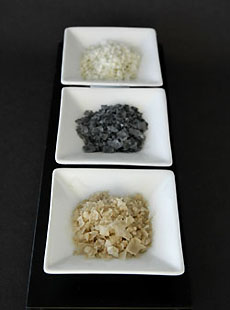

Coarse grain sea salts add beauty to dishes. Sprinkle a few grains of color-contrasting salts onto whatever you’re serving. Photo by Dhanraj Emanuel | THE NIBBLE.
September 2005
Last Updated May 2016
|
 |
All Types Of Salt: Culinary Salt Glossary
Page 2: Celtic Salt & Other Salt Types Beginning With
C ~ E
This is Page 2 of a 7-page glossary of all types of salt used for culinary purposes. Some of the terms you’ll find below include canning salt, Celtic salt and curing salt. After you’ve read up on sea salt, take a look at our many other food glossaries—an easy way to get up to speed on almost 100 different food categories. |
Click on a letter to get to the appropriate glossary page.
a b c d e f g h i j k l m n o p q r s t u v w x y z
This glossary is protected by copyright and cannot be reproduced in whole or in part.
You are welcome to link to it.
CANNING SALT
See pickling salt.
CELTIC SALT
A grey French sea salt, hand harvested using the Celtic method of wooden rakes allowing no metal to touch the salt. Celtic salts are available ground in different levels of coarseness. See sel gris.
|
|

Celtic salt. Photo courtesy SaltWorks.us. |
CHLORIDE
Along with sodium, chloride is one of the two elements that make up salt. According to the Salt Institute, chloride is essential for human nutrition, as it preserves acid-base balance in the body, aids potassium absorption, supplies the essence of digestive stomach acid, and enhances the ability of the blood to carry carbon dioxide from respiring tissues to the lungs. See also sodium and sodium chloride.
CITRIC SALT or SOUR SALT or CITRIC ACID
A salt substance derived from acidic citrus fruits, such as lemon and limes, that is dried and formed into a powder or crystal. When used as an ingredient to flavor foods, it provides a distinctively sour or tart taste. It is a common substance used in sausage making and in canning, to keep the color of fruits from darkening, and is commonly used as a substitute for lemon juice. It is also called for used in some recipes (often called sour salt).
|
COARSE SALT or GROS SEL or SALE GROSSO
Coarse salt is a larger-grained sea salt crystal. Most recipes calling for salt imply finely ground salt; however, many professional chefs prefer cooking with coarse salt because they can easily measure it with their fingers. It is less moisture-sensitive so it resists caking and is easily stored. Coarse salt is useful for making beds for oysters and salt crusts on meat or fish, for lining baking dishes and the rims of Margarita glasses. Kosher salt and most sea salt come coarsely ground. Compare the grain of the coarse salt at right with the fine-grained Celtic salt, above.
|
|

Coarse sal. Photo courtesy SaltWorks.us. |
CURING SALT
Salt used in curing and preserving food, a mixture of approximately 94% salt and approximately 6% sodium nitrite. It is generally dyed a pink color so that it can be easily recognized from regular salts.
|
CYPRUS SEA SALT
Cyprus sea salt is natural flake salt harvested from the Mediterranean Sea around the island of Cyprus. It can take up to two years for the weather and temperature to create the right balance, so that artisans can create the salt. The beautiful, crisp/crunchy, pyramid-shaped crystals are used to garnish dishes or create salt rims for cocktails. For the black crystals, activated charcoal is added for a dramatic appearance and softer flavor.
DANISH SMOKED SALT
A Viking salt, it is produced by evaporating seawater in a big vessel over an open, smoky fire containing juniper, cherry, elm beech and oak. Rub a small amount into salmon or other fish prior to grilling or roasting.
EARTH SALT
A salt that is mined, as opposed to evaporated from sea water. Table salt and black salt are examples.
Go To Page 3: Salt Terms Beginning With
Letters F ~ G
Go To The Article Index Above
|
|

Above, white Cyprus flake salt. Photo courtesy ArtisanSalt.com.

Cyprus back lava salt is created by adding activated charcoal for dramatic effect. Photo courtesy SaltWorks.us.
|
© Copyright 2005-2025 Lifestyle Direct, Inc. All rights reserved. All images are copyrighted to their respective owners.
|








